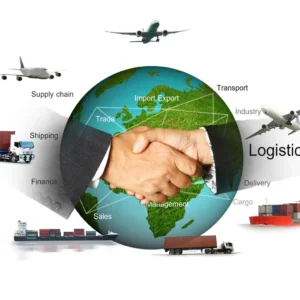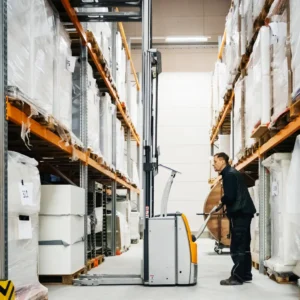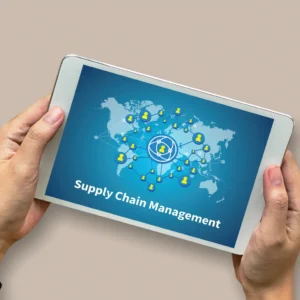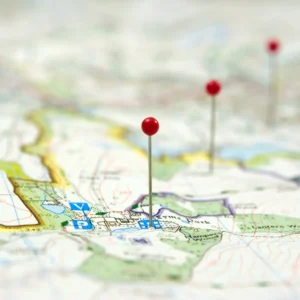
Revolutionizing Logistics
AI Tools for Fleet Maintenance, Monitoring, and Optimization in the Transport Industry's Technological Frontier
Integrating advanced technologies has become imperative in the fast-evolving landscape of transportation logistics. AI Tools for Fleet Maintenance and Monitoring in the Logistics Industry represent a pivotal shift towards enhanced efficiency, safety, and cost-effectiveness. These tools encompass a holistic approach to streamlining operations, addressing maintenance challenges, and optimizing overall fleet performance.
In a sector where timely maintenance and operational precision are paramount, Artificial Intelligence promises to revolutionize traditional practices. From Predictive Maintenance for Vehicles, which proactively minimizes downtime, to Fuel Efficiency Optimization, ensuring cost savings and environmental sustainability, these tools collectively contribute to a comprehensive solution.
The discussion explores the intricacies of logistics tools, including business knowledge requirements, software and hardware specifications, integration complexities, and the benefits for innovative organizations.
Table of Contents

Arindam Roy
An Automation Consultant with 25+ years of IT Experience
5 AI Tool ideas for Fleet Maintenance and Monitoring
The tools you’ve outlined for Fleet Maintenance and Monitoring in the Transportation and Logistics industry can significantly benefit from AI technologies. Here’s an elaboration on each tool:
Predictive Maintenance for Vehicles:
- Objective: Minimize unplanned downtime and reduce maintenance costs by predicting when vehicle components will likely fail.
- AI Application: Utilize machine learning algorithms to analyze historical data, sensor readings, and real-time performance metrics. The system can then predict when specific parts require maintenance, allowing for proactive repairs or replacements.
Fuel Efficiency Optimization:
- Objective: Enhance fuel efficiency to reduce costs and environmental impact.
- AI Application: Implement AI algorithms that analyze driving patterns, weather conditions, and traffic data. This can optimize route planning and speed control and suggest fuel-efficient driving behaviours to drivers. Machine learning models can learn and adapt continuously, improving fuel efficiency.
Driver Behavior Analytics:
- Objective: Improve driver safety, reduce accidents, and enhance fleet performance.
- AI Application: Employ machine learning to analyze driver behaviour, considering factors like speed, harsh acceleration, braking patterns, and adherence to traffic rules. The system can offer drivers instant feedback and produce valuable insights for training programs. This helps identify high-risk behaviours and promote safer driving practices.
Automated Vehicle Inspection:
- Objective: Streamline and enhance the vehicle inspection process for efficiency and accuracy.
- AI Application: Use computer vision and image recognition to automate the inspection of vehicles. Cameras and sensors can be employed to capture images of the car, and AI algorithms can analyze these images to detect potential issues or damage. This aids in quick and reliable inspection, reducing manual effort and ensuring a thorough examination.
Telematics for Fleet Tracking:
- Objective: Monitor and manage the entire fleet’s location, status, and performance in real time.
- AI Application: Combine telematics data with machine learning algorithms to predict arrival times, optimize routes based on live traffic conditions, and identify areas for operational improvements. AI can also assist in theft prevention by analyzing unusual patterns in vehicle movement.
By integrating these AI-driven tools into the Transportation and Logistics industry, businesses can experience improved operational efficiency, cost savings, and a reduced likelihood of unexpected issues. Additionally, the continuous learning capabilities of AI models contribute to ongoing optimization and adaptation to changing conditions in the transportation sector.
Predictive Maintenance for Vehicles Tool
Business Knowledge Requirements:
- Fleet Management Domain Knowledge: Understanding the dynamics of fleet management, vehicle usage patterns, and the impact of maintenance on overall logistics operations.
- Understanding Vehicle Components: In-depth knowledge of the various components of the vehicles, their failure patterns, and the criticality of timely maintenance.
- Operational Workflow: Familiarity with the operational workflows of maintenance teams and how predictive maintenance fits into the existing processes.
Software Requirements:
- Machine Learning Algorithms: Development of machine learning models for predictive maintenance, capable of analyzing historical data and real-time sensor readings to predict component failures.
- Data Processing and Storage: Efficiently store and process large volumes of historical and real-time data.
- User Interface for Monitoring: Development of a user-friendly interface for maintenance managers to monitor the predictions, schedule proactive maintenance, and track the overall health of the fleet.
Hardware Requirements:
- Telematics Devices: Installation of telematics devices on vehicles to capture real-time sensor readings and performance metrics.
- Computing Resources: Sufficient computing power for running machine learning algorithms, significantly as the fleet size increases.
Integration Requirements to Existing Toolset:
- Fleet Management Systems Integration: Seamless integration with existing Fleet Management Systems (FMS) to access vehicle data, maintenance records, and operational schedules.
- Telematics Integration: Integration with telematics systems to gather real-time vehicle performance data.
Training Required for Existing Staff to Run the Tool:
- Understanding Predictive Maintenance Results: Training sessions for maintenance teams to interpret and act upon the predictions generated by the tool.
- User Interface Familiarization: Training on using the tool’s interface to monitor vehicle health and schedule proactive maintenance.
Challenges and Workarounds in Implementing the Tool:
- Data Quality and Availability:
- Challenge: Ensuring that historical and real-time data are accurate and readily available.
- Workaround: Implement data validation checks and regular updates and collaborate with telematics providers for reliable data.
- Integration Complexity:
- Challenge: Integrating the predictive maintenance tool seamlessly with existing fleet management systems.
- Workaround: Develop standardized APIs for smooth integration and collaborate closely with system vendors.
- User Adoption:
- Challenge: Resistance from maintenance teams to trust and adopt the predictive maintenance tool.
- Workaround: Conduct thorough training sessions, demonstrate the tool’s effectiveness through pilot projects, and involve maintenance teams in the tool’s development process.
Similar Tools Already Available in the Market:
- Uptake: Offers predictive maintenance solutions for various industries, including transportation.
- IBM Watson IoT: Provides predictive maintenance capabilities leveraging IoT data.
Cost and Benefit Analysis:
- Costs:
- Development Costs: Investment in hiring AI developers, data scientists, and software engineers to build the predictive maintenance tool.
- Hardware Costs: Expenses for installing telematic devices on the fleet.
- Integration Costs: Resources are required to integrate the predictive maintenance tool with existing fleet management systems.
- Training Costs: Budget for training maintenance staff on effectively using the predictive maintenance tool.
- Benefits:
- Reduced Downtime: Proactive maintenance minimizes unplanned downtime, ensuring vehicles are operational when needed.
- Cost Savings: Avoidance of major breakdowns results in cost savings on emergency repairs and potential vehicle replacements.
- Extended Vehicle Lifespan: Predictive maintenance contributes to the overall longevity of the fleet, delaying the need for new vehicle acquisitions.
Recommendation: Integrate with Similar Available Products:
Considering the specialized nature of AI tools for fleet maintenance and monitoring in transportation and logistics automation, integration with solutions like Uptake or IBM Watson IoT is recommended.
Fuel Efficiency Optimization Tool
Business Knowledge Requirements:
- Transportation Operations Understanding: In-depth knowledge of the fleet’s daily operations, routes, and schedules to align fuel optimization strategies with overall logistics efficiency.
- Understanding Fuel Efficiency Factors: Familiarity with the factors influencing fuel efficiency, such as driving patterns, vehicle conditions, and external variables like weather and traffic.
- Regulatory Compliance Knowledge: Awareness of environmental regulations related to fuel emissions to ensure that the tool contributes to compliance.
Software Requirements:
- Route Optimization Algorithms: Development of algorithms that optimize routes based on real-time traffic data, historical patterns, and other relevant factors.
- Machine Learning Models: Implementing machine learning models that analyze driving patterns and recommend fuel-efficient behaviours. The models should continuously learn and adapt to changing conditions.
- User Interface for Drivers and Managers: Creation of user interfaces for both drivers and fleet managers to visualize optimization suggestions, monitor fuel efficiency, and track overall performance.
Hardware Requirements:
- Telematics Devices: Installation of telematics devices on vehicles to capture real-time driving data and transmit it to the optimization system.
- Onboard Diagnostics (OBD) Systems: Integration with OBD systems to monitor vehicle conditions and identify potential issues affecting fuel efficiency.
Integration Requirements to Existing Toolset:
- Fleet Management Systems Integration: Seamless integration with existing Fleet Management Systems (FMS) to access data on routes, schedules, and vehicle conditions.
- Telematics Integration: Integration with telematics systems to receive real-time driving data for analysis.
Training Required for Existing Staff to Run the Tool:
- Driver Training Programs: Training sessions for drivers to understand AI-driven recommendations and adopt fuel-efficient driving behaviours.
- Managerial Training: Training fleet managers to interpret optimization results, implement strategies, and make informed decisions based on the tool’s insights.
Challenges and Workarounds in Implementing the Tool:
- Driver Resistance:
- Challenge: Drivers may be resistant to changes in driving behaviour.
- Workaround: Conduct comprehensive training programs, highlight the benefits of fuel efficiency for both the organization and drivers, and provide incentives for adherence.
- Real-time Data Accuracy:
- Challenge: Ensuring real-time data accuracy for precise route optimization.
- Workaround: Implement robust data validation processes, utilize reliable telematics devices, and integrate with reputable real-time data sources.
Similar Tools Already Available in the Market:
- Geotab’s Fuel Management Solution: Offers fuel usage tracking, route optimization, and driver behaviour analysis for fuel efficiency.
- Verizon Connect Reveal: Provides route planning, fuel management, and real-time tracking solutions to optimize fleet operations.
Cost and Benefit Analysis:
- Costs:
- Development Costs: Investment in hiring AI developers, data scientists, and software engineers to build the fuel efficiency optimization tool.
- Hardware Costs: Expense for installing telematics devices and ensuring compatibility with existing onboard systems.
- Integration Costs: Resources are required to integrate the optimization tool with existing fleet management and telematics systems.
- Training Costs: Budget for driver and managerial training programs.
- Benefits:
- Fuel Cost Savings: Reduced fuel consumption leads to direct cost savings for the organization.
- Environmental Impact: Improved fuel efficiency reduces carbon emissions, aligning with environmental sustainability goals.
- Operational Efficiency: Optimized routes and driving patterns contribute to overall operational efficiency, reducing delays and improving delivery times.
Recommendation: Integrate with Similar Available Products:
Considering the specialized nature of AI tools for fleet maintenance and monitoring in transportation and logistics automation, integration with existing solutions like Geotab or Verizon Connect is recommended.
Driver Behavior Analytics Tool
Business Knowledge Requirements:
- Transportation Regulations: Understanding transportation regulations related to driver behaviour and safety standards.
- Driver Psychology: Knowledge of human behaviour and psychology to accurately interpret driver actions and reactions.
- Fleet Management Practices: Familiarity with fleet management practices to align driver behaviour analytics with overall operational goals.
Software Requirements:
- Machine Learning Algorithms: Development of machine learning models capable of analyzing driver behaviour data and identifying patterns indicative of risky driving.
- Real-time Data Processing: Implementation of real-time data processing systems to analyze driver behaviour as it happens and provide instant feedback.
- User Interface for Visualization: Creation of user interfaces for fleet managers to monitor driver behaviour analytics and generate insights for training programs.
Hardware Requirements:
- Telematics Devices: Installation of telematics devices on vehicles to capture real-time driver behaviour data, such as speed, acceleration, and braking.
- Onboard Cameras: Integration with onboard cameras to capture visual data for analyzing driver actions and identifying risky behaviours.
Integration Requirements to Existing Toolset:
- Fleet Management Systems Integration: Seamless integration with existing Fleet Management Systems (FMS) to access vehicle data and driver profiles for comprehensive analytics.
- Telematics Integration: Integration with telematics systems to receive real-time driver behaviour data and route it to the analytics platform.
Training Required for Existing Staff to Run the Tool:
- Understanding Driver Behavior Metrics: Training sessions for fleet managers and safety officers to understand the metrics for analyzing driver behaviour and interpreting the results.
- Utilizing Insights for Training Programs: Training programs for driver trainers to effectively use insights from driver behaviour analytics for targeted training interventions.
Challenges and Workarounds in Implementing the Tool:
- Data Privacy Concerns:
- Challenge: Ensuring compliance with data privacy regulations while collecting and analyzing driver behaviour data.
- Workaround: Implement strict data anonymization protocols and obtain driver consent for data collection and analysis.
- Driver Resistance:
- Challenge: Drivers may resist being monitored and receiving feedback on their behaviour.
- Workaround: Communicate the benefits of driver behaviour analytics for safety and performance improvement, provide coaching and support for behaviour change, and offer incentives for positive outcomes.
Similar Tools already available in the market:
- Samsara Driver Safety Solutions: Offers real-time driver behaviour monitoring and analytics to improve safety and performance.
- KeepTruckin (now Motive) Smart Dashcam: Provides driver behaviour analytics based on video recordings and telematics data for enhanced safety and compliance.
Cost and Benefit Analysis:
- Costs:
- Development Costs: Investment in hiring AI developers, data scientists, and software engineers to build the driver behaviour analytics platform.
- Hardware Costs: Expense for installing telematics devices, onboard cameras, and other hardware components on the fleet.
- Integration Costs: Resources are required to integrate the analytics platform with fleet management and telematics systems.
- Training Costs: Budget for training fleet managers, safety officers, and driver trainers on using the analytics platform and interpreting insights for training programs.
- Benefits:
- Improved Safety: Reduction in accidents and injuries resulting from unsafe driving behaviours, leading to lower insurance costs and improved reputation.
- Enhanced Fleet Performance: Optimization of driver behaviour for fuel efficiency, vehicle maintenance, and overall operational efficiency.
- Compliance and Risk Mitigation: Ensuring compliance with regulatory standards and reducing the risk of fines and legal liabilities associated with unsafe driving practices.
Recommendation: Integrate with Similar Available Products:
Considering the specialized nature of AI tools for fleet maintenance and monitoring in transportation and logistics automation, integrating with existing solutions like Samsara or KeepTruckin is recommended.
Automated Vehicle Inspection Tool
Business Knowledge Requirements:
- Vehicle Maintenance Standards: In-depth knowledge of vehicle maintenance standards and regulatory requirements for thorough inspections.
- Fleet Maintenance Processes: Understanding existing fleet maintenance processes and how automated vehicle inspection aligns with overall maintenance workflows.
- Visual Inspection Criteria: Knowledge of visual inspection criteria for different types of vehicles and potential issues that need to be identified.
Software Requirements:
- Computer Vision and Image Recognition Algorithms: Development of computer vision and image recognition algorithms to analyze images captured during vehicle inspections and detect anomalies or issues.
- Data Management System: A robust data management system is implemented to store and organize inspection results, facilitating trend analysis and reporting.
- User Interface for Inspection Results: Creating a user-friendly interface for maintenance staff to review automated inspection results, make decisions, and generate reports.
Hardware Requirements:
- Cameras and Sensors: Installation of high-resolution cameras and sensors on inspection stations to capture detailed images of vehicles.
- Computing Resources: Adequate computing power for running complex image recognition algorithms efficiently.
Integration Requirements to Existing Toolset:
- Fleet Management Systems Integration: Integration with existing Fleet Management Systems (FMS) to incorporate automated inspection results into maintenance records.
- Workflow Integration: Seamless integration with existing maintenance workflows ensures that automated inspections complement manual and other maintenance activities.
Training Required for Existing Staff to Run the Tool:
- Tool Operation Training: Training sessions for maintenance staff to operate and navigate the automated vehicle inspection tool effectively.
- Interpreting Results: Training on interpreting inspection results generated by the AI algorithms, including understanding the severity of issues detected.
Challenges and Workarounds in Implementing the Tool:
- Accuracy of AI Algorithms:
- Challenge: Ensuring the accuracy of AI algorithms in detecting issues during vehicle inspections.
- Workaround: Implement a robust training dataset, regularly update the algorithms based on feedback and new data, and include a manual verification step.
- Integration Complexity:
- Challenge: Integrating the automated inspection tool seamlessly with fleet management and maintenance systems.
- Workaround: Develop standardized APIs for smooth integration and collaborate closely with system vendors to ensure compatibility.
Similar Tools already available in the market:
- UVeye: Uses advanced AI and deep learning for automated vehicle inspection, detecting anomalies in the chassis, tyres, and other components.
Cost and Benefit Analysis:
- Costs:
- Development Costs: Investment in hiring AI developers, computer vision specialists, and software engineers to build the automated vehicle inspection tool.
- Hardware Costs: Expense for acquiring and installing high-quality cameras and sensors on inspection stations.
- Integration Costs: Resources are required to integrate the automated inspection tool with existing fleet management and maintenance systems.
- Training Costs: Budget for training maintenance staff on using the automated inspection tool and interpreting results.
- Benefits:
- Efficiency Gains: Automated inspections reduce the time and effort required for vehicle checks, enhancing overall maintenance efficiency.
- Accuracy and Consistency: AI algorithms provide consistent and objective inspection results, minimizing human error and bias.
- Preventive Maintenance: Early detection of issues allows for preventive maintenance, reducing the likelihood of significant breakdowns and associated costs.
Recommendation: Integrate with Similar Available Products:
Considering the specialized nature of AI tools for fleet maintenance and monitoring in transportation and logistics automation, integrating with existing solutions like UVeye or Taranis is recommended.
Telematics for Fleet Tracking Tool
Business Knowledge Requirements:
- Fleet Operations Understanding: In-depth knowledge of fleet operations, including routes, schedules, and the impact of real-time tracking on overall efficiency.
- Logistics Optimization: Understanding logistics optimization principles to align telematics data with machine learning algorithms for route optimization and operational improvements.
- Theft Prevention Strategies: Familiarity with theft prevention strategies and the ability to translate them into AI algorithms for analyzing unusual vehicle movement patterns.
Software Requirements:
- Telematics Data Processing System: Development of a robust telematics data processing system capable of handling real-time location updates, vehicle status information, and other relevant data.
- Machine Learning Algorithms: Implement machine learning models for predicting arrival times, optimizing routes, and identifying areas for operational improvements based on telematics data.
- User Interface for Fleet Managers: Creation of a user-friendly interface for fleet managers to monitor the entire fleet’s real-time location, status, and performance.
Hardware Requirements:
- Telematics Devices: Telematics devices on vehicles are installed to capture and transmit real-time location and performance data.
- Computing Resources: Adequate computing power for processing and analyzing large volumes of telematics data in real-time.
Integration Requirements to Existing Toolset:
- Fleet Management Systems Integration: Seamless integration with existing Fleet Management Systems (FMS) to synchronize telematics data with overall fleet operations.
- Route Optimization Integration: Integration with existing route optimization tools to enhance efficiency and accuracy.
Training Required for Existing Staff to Run the Tool:
- Telematics Data Interpretation: Training sessions for fleet managers to interpret and leverage telematics data for decision-making.
- Machine Learning Model Understanding: Training on understanding and interpreting results generated by machine learning models, especially for route optimization and predictive analytics.
Challenges and Workarounds in Implementing the Tool:
- Data Security Concerns:
- Challenge: Ensuring the security and privacy of sensitive telematics data.
- Workaround: Implement robust encryption measures, access controls, and compliance with data protection regulations.
- Integration Complexity:
- Challenge: Integrating the telematics tool seamlessly with fleet management and optimization systems.
- Workaround: Develop standardized APIs, conduct thorough testing, and collaborate closely with system vendors for compatibility.
- Driver Acceptance:
- Challenge: Potential resistance from drivers regarding continuous monitoring.
- Workaround: Communicate the benefits of telematics for operational efficiency, safety, and theft prevention. Involve drivers in the process and address concerns transparently.
Similar Tools already available in the market:
- Geotab: Offers telematics solutions with real-time tracking, route optimization, and predictive analytics.
- Samsara: Provides fleet tracking and management solutions with AI-driven insights for optimization.
Cost and Benefit Analysis:
- Costs:
- Development Costs: Investment in hiring AI developers, data scientists, and software engineers to build the telematics for the fleet tracking tool.
- Hardware Costs: Expenses for acquiring and installing telematic devices on the entire fleet.
- Integration Costs: Resources are required to integrate the telematics tool with existing fleet management and optimization systems.
- Training Costs: Budget for training fleet managers using the telematics tool and interpreting machine learning-driven insights.
- Benefits:
- Real-time Visibility: Enhanced visibility into the real-time location and performance of the entire fleet, leading to better decision-making.
- Operational Efficiency: Route optimization and improvements based on machine learning insights contribute to overall efficiency.
- Theft Prevention: AI-driven analysis of unusual movement patterns aids in theft prevention, protecting assets and reducing losses.
Recommendation: Integrate with Similar Available Products:
Considering the specialized nature of AI tools for fleet maintenance and monitoring in transportation and logistics automation, integrating with existing solutions like Geotab or Samsara is recommended.
Conclusion on AI tools for fleet maintenance and monitoring in transportation and logistics
In conclusion, developing AI tools for Fleet Maintenance and Monitoring in the logistics industry presents a transformative opportunity for increased efficiency, safety, and cost-effectiveness. The selected tools, including Predictive Maintenance for Vehicles, Fuel Efficiency Optimization, Automated Vehicle Inspection, and Telematics for Fleet Tracking, collectively contribute to a comprehensive solution for streamlined operations.
By utilizing AI for Predictive Maintenance, organizations can prevent unplanned downtime and reduce maintenance costs by proactively addressing vehicle component failures. Fuel Efficiency Optimization ensures cost savings and environmental impact reduction through AI-driven route planning and driving behaviour analytics. Automated Vehicle Inspection improves efficiency and accuracy by utilizing computer vision, reducing manual effort, and ensuring thorough examinations.
Telematics for Fleet Tracking enables real-time monitoring and management of the entire fleet. Integrating telematics data with machine learning algorithms allows for predictive analytics, optimizing routes, and enhancing operational visibility. The recommendation to integrate with existing solutions like Geotab or Samsara is based on factors such as industry expertise, time-to-market advantages, cost-efficiency, and scalability.
In the dynamic transportation and logistics industry landscape, adopting these AI tools positions the organization as an IT/AI pioneer and addresses critical challenges such as data security, integration complexities, and driver acceptance. The collective implementation of these tools promises to elevate fleet management to new heights, ensuring a future-ready, technologically advanced approach to transportation logistics.
Related Articles
- AI Tools for Predictive Analytics and Business Intelligence
- AI Tools for Sustainability and Green Logistics
- AI Tools for Compliance and Regulatory Support
- AI Tools for Operational Efficiency and Automation
- AI Tools for Supply Chain Visibility and Collaboration
- AI Tools for Order and Shipment Tracking
- AI Tools for Warehouse Management and Automation
- AI Tools for Route Optimization and Planning
- AI Tools for Risk Management and Security
- AI tools in the Transportation and Logistics industry





























